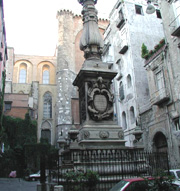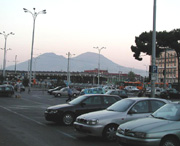意大利城市-那不勒斯
Naples (Italy)
 Naples is raucous(乱哄哄的), polluted, anarchic, deafening, crumbling and grubby(肮脏的). It's also a lot of fun. Superbly positioned on a bay, Naples has a little - and often a lot - of everything. It pulsates(有规律地跳动)with noisy street markets and swarms of people buzzing around on Vespas(小型摩托车)with no regard for traffic rules.
Naples is raucous(乱哄哄的), polluted, anarchic, deafening, crumbling and grubby(肮脏的). It's also a lot of fun. Superbly positioned on a bay, Naples has a little - and often a lot - of everything. It pulsates(有规律地跳动)with noisy street markets and swarms of people buzzing around on Vespas(小型摩托车)with no regard for traffic rules.The old centre bristles with ancient churches, a medieval university and countless eateries and cafes. It also has a reputation for organised crime. But the city forges on, powered by the sheer zest and vitality of its inhabitants. Despite its faults, Naples might be 'the loveliest spot in Europe'.
The best time to visit is from April to June, when prices are lower. Late July and August is the time to avoid Italy altogether - the weather boils, prices are inflated and the whole country swarms with holidaymakers. Most Italians go on holiday in August, abandoning the cities and leaving many shops, hotels and restaurants closed.
Soon after founding Cumae in 1000 BC, colonists from Rhodes established a settlement on the western side of Mt Vesuvius(维苏威火山). Many centuries later, Phoenician traders(腓尼基商人)from present day Lebanon and Greeks from Athens were attracted by the splendour of the coast and so expanded the settlement, christening it Neapolis (New City). It thrived as a centre of Greek culture and later, under Roman rule, became a favourite of emperors Pompey, Caesar and Tiberius.
 After successive waves of invasion by the wild Goths(哥特人)and a couple of spells under Byzantium(拜占庭), Naples remained an independent dukedom(公爵领地)for about 400 years until captured by the Normans in 1139. They in turn were replaced by the German Hohenstaufens (who ruled until 1266), then Charles I of Anjou, who took control of the Kingdom of Sicily and turned Naples into its de facto capital. The Angevins were succeeded by the Spanish house of Aragón, under whom the city came to prosper.
After successive waves of invasion by the wild Goths(哥特人)and a couple of spells under Byzantium(拜占庭), Naples remained an independent dukedom(公爵领地)for about 400 years until captured by the Normans in 1139. They in turn were replaced by the German Hohenstaufens (who ruled until 1266), then Charles I of Anjou, who took control of the Kingdom of Sicily and turned Naples into its de facto capital. The Angevins were succeeded by the Spanish house of Aragón, under whom the city came to prosper.
In 1503 Naples and the Kingdom of Sicily were absorbed by Spain, which sent viceroys(总督)to reign as virtual dictators. Despite their heavy-handed rule, Naples flourished artistically and acquired much of its splendour during this period. Indeed it continued to flower when the Spanish Bourbons(波旁皇族)reestablished Naples as capital of the Kingdom of the Two Sicilies in 1734. Aside from a Napoleonic interlude (1806 to 1815), the Bourbons remained until 1860, when they were unseated by Garibaldi and the Kingdom of Italy.
The city was heavily damaged during more than 100 bombing raids in WWII - marks can still be seen on many monuments. The Allies subsequently presided over a disastrous period of transition from war to peace - many observers have since attributed the initial boom in the city's organised crime, at least in part, to members of the occupying forces. A severe earthquake in 1980 and the dormant, but not extinct Vesuvius looming to the east, remind Neapolitans of their city's vulnerability.